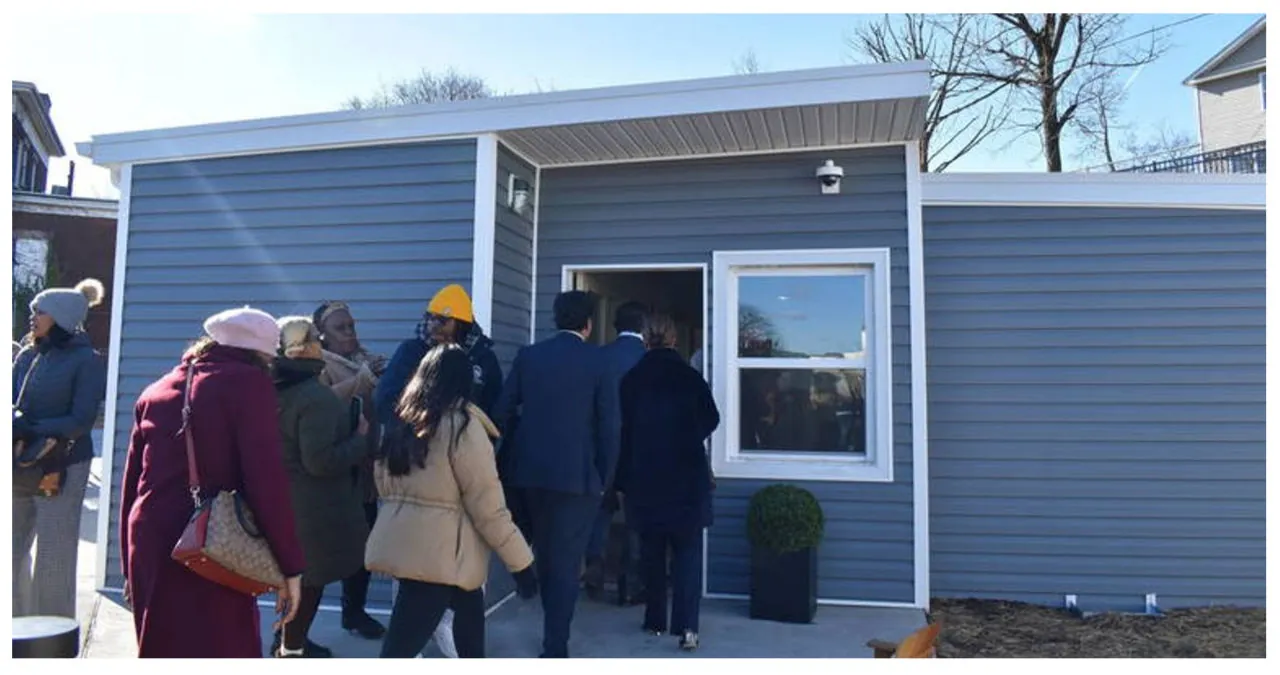Mocobizscene-The city of Newark has recently unveiled a new initiative to provide immediate shelter for those in need. On Monday, January 8, officials announced the opening of a 20-bed “bridge housing community.” This facility aims to offer a temporary solution for individuals who require immediate housing assistance.
Officials marked the inauguration of the transitional housing center, known as “Hope Village II,” constructed from seven shipping containers at 51-63 Elizabeth Ave. A large crowd of several hundred individuals attended the ribbon-cutting ceremony and had the opportunity to explore the units. These units were fully furnished with comfortable beds, well-equipped kitchens, and clean bathrooms. The interiors were also adorned with beautiful paintings, enhancing the overall ambiance.
“Hope Village II represents a significant departure from Hope Village I, as it serves as a testament to the lessons we have learned,” emphasized Mayor Ras J. Baraka. “Throughout this journey, we have acknowledged both our successes and our missteps.”
The City Council has given its approval for the project, allocating a budget of up to $4.78 million. This includes four amendments to the original cost of $1.85 million, which was initially authorized in 2021. However, it has been noted by a city spokesperson that the council’s final amendment resulted in an allocation of funds exceeding the actual requirement.
Hope Village II, which consists of seven converted shipping containers, offers five four-bedroom units, according to officials. The unique aspect of Hope Village II is the additional outdoor community space it provides, as mentioned by Luis Ulerio, the director of the mayor’s Office of Homeless Services.
Ulerio added that these clusters are in contrast to the single units found in Hope Village I.
In collaboration with the Nature Conservancy based in New Jersey, the city successfully obtained a $28,000 grant to acquire a variety of greenery for the site. This includes 30 evergreen trees, 37 shrubs, and 16 ornamental trees.
The city was able to secure a $94,000 grant from the Rutgers Department of Family and Community Health Sciences. This funding will be used to support various initiatives, including the construction of greenhouses and community gardens. Additionally, the grant will also be used to organize food and nutrition education workshops.
The new units feature vinyl siding, giving them the appearance of residential buildings. This is a notable departure from the bare appearance of the shipping container units at Hope Village I.
Lamont Johnson, aged 60, was one of the attendees present at the ribbon cutting ceremony. He shared that he has been facing challenges in finding suitable housing and expressed his optimism about the potential benefits of residing at Hope Village II.
“I find myself in this situation due to some health issues,” Johnson explained. “Fortunately, I am currently on the path to recovery and require a place like this to fully heal before I can resume my work.”
Ulerio stated that Hope Village I has successfully assisted more than 50 individuals in transitioning to permanent housing within its initial three years of operation.
“It serves as a springboard for individuals to begin constructing their own paths of growth and development,” he expressed.
According to Ulerio, the length of stay can vary and there is no set standard duration for it.
According to him, every individual has their own unique story and journey. Therefore, it is crucial to consider and understand their individual experiences. This process begins with an initial assessment where their difficulties and strengths are identified and acknowledged.
In an interview, Craig Mainor, the Executive Director of United Community Corporation (UCC), stated that UCC offers case management, supervision, and improved housing placement for the residents of the Hope villages.
According to Mainor, their organization plays a crucial role in providing shelter and support to individuals in need. They not only fill the available beds but also assist people in transitioning to more permanent housing. Moreover, they take pride in their ability to facilitate 50 permanent placements, demonstrating their commitment to making a lasting impact on the lives of those they serve.
The Newark Housing Authority offers Section 8 vouchers, which are then utilized by UCC to collaborate with local landlords and property managers in order to fill their vacant units.
Mainor explained that their organization provides ongoing support to individuals or couples who have been placed into permanent housing. “If you’ve been on the street for years, one of the challenges of transitioning into permanent housing is being able to maintain your responsibilities,” Mainor stated. They work closely with these individuals or couples to ensure they can successfully adapt to their new living situation and fulfill their obligations.
According to Janel Winters, the director of the state Division of Housing & Community Resources, New Jersey allocates a large number of housing vouchers to Newark. Winters explained that the creation of shipping container housing is a fast-tracked method to provide shelter for individuals in need.
“The remarkable aspect of this situation is the entire community, including its leaders, acknowledging the urgency and rejecting the notion of waiting,” Winters expressed. “We refuse to adhere to the customary procedures; instead, we are determined to find ways to expedite and achieve our goals as swiftly as possible.”
Also Read:
- Fatal incident in New Orleans: Jacob Carter, co-founder of Howdy Bagel, dies while on vacation with husband Daniel
- Fatal shooting in Northwest DC Kills One
- Family Grieves The Loss Of Grandfather Killed In Hit-And-Run Crash Captured On Video In South LA



